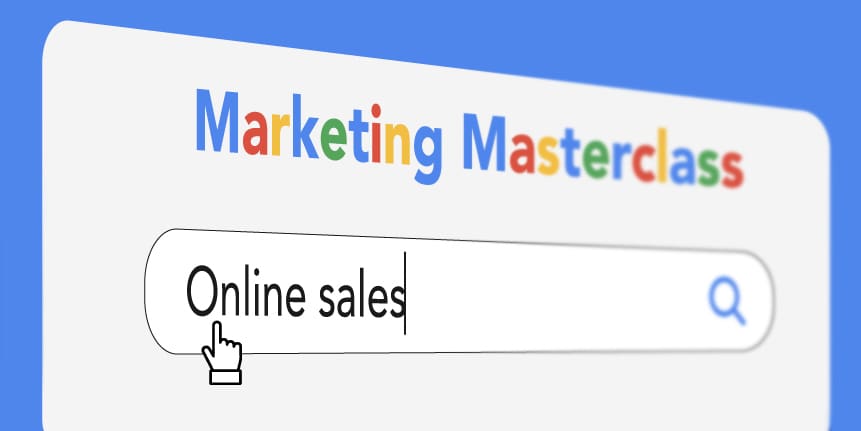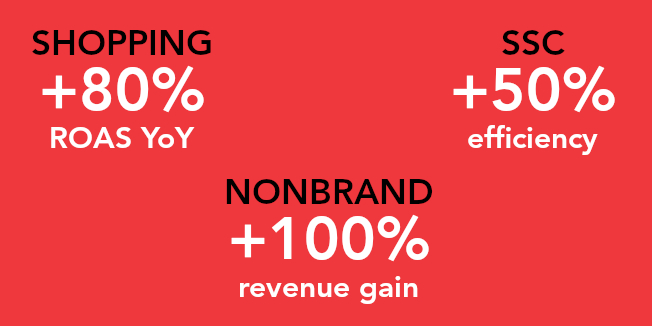
Navigate an unpredictable landscape with actionable, data-driven strategies tailored for your business from the brand down to the local level.

It’s one thing to talk about transformational growth, but it’s something else to actually go out into the world and achieve it—time and time again. So let’s keep it real, shall we? In this three-part series, we’re going to take a closer look at some of our most successful Google-oriented campaigns in three distinct digital marketing arenas: Online sales, brand awareness, and lead generation.
From strategic inception to tangible outcomes, we start with the definitive “Show, don’t tell” story of an exceptionally effective ecommerce campaign. Here’s how we exceeded all expectations for a valued client during a truly tumultuous time for retailers everywhere—and made the best possible use of our partnership with Google.
Broadly speaking, our strategic process begins with a single question rooted in a problem, challenge, or goal our client is facing. To begin answering that question, we gather insights and recommendations from every relevant subject matter expert—in analytics, content strategy, CRM, media, SEO, and more—to form a cohesive, realistic, and well-rounded strategy that covers aspects including:
After defining a timeline to tie tangible actions to each step of the strategy (ideas are great, but organized, actionable, realistic ideas are better!), we move on to execution, calling on our sheer depth of expertise—and strong partnerships with vendors—to diligently and intelligently move through build, launch, and growth.
Media planning across Google products demands historic analysis and alignment with each client’s seasonal calendar and business growth objectives. After evaluating the potential for growth of online sales from existing products, we work closely with our Google Account Strategists to determine net new products that align to sales growth.

Our relationship with Google, in fact, has become essential, and we’re among the first to know about upcoming product release information, betas, and in-platform training and troubleshooting. Although media specialists at DAC are usually dedicated to specific clients, we tap into the diverse, hands-on experience across our entire media team to better assess product mix—whether they’re based in the same office or on the other side of the Atlantic.
Finally, we work closely with our clients to align Google products to their marketing plan, which focuses our view on specific products, categories, themes, and patterns by month. Can we support creative and content needs for these ad types? Are we able to target the right audiences with these products? Each month we meet with our client contacts to align media plans to marketing plans.
Automated bid strategies such as Target ROAS, Target CPA, and Target IS are helping to drive ongoing growth across our client programs. For instance, in 2019 we tested the first use of automated Smart Bidding strategies against branded search campaigns for a high-profile client. This client program—which we will consider in greater detail from this point on—now exclusively uses automated bidding methods across the entire portfolio of Google products, including Shopping and Dynamic Display.
Smart Bidding has given us the confidence and ability to gradually scale spend while homing in on specific and measurable targets. Such automation is not only driving performance at scale; it also allows our specialists to spend more time on keyword growth, budget optimization, testing plans, and assessing incremental opportunities. In short, we have more time to hone our craft through in-depth analysis of performance data across all digital channels.

Graphic: Google
In addition to Smart Bidding, we have also embraced Smart Shopping in the past year. This feed-driven tactic allows fast segmentation of products and integration of new products on the fly, while creating a direct link between Google users searching for new products and our client’s full catalog.
Outside of Google’s robust suite of automated ad products, we also use internal data automation from multiple data streams to report on program performance and conduct ad-hoc analyses—covering everything from customer data and sales metrics to website and product feed performance.
A successful online sales campaign is one that delivers the right content to the right audience at the right moments to drive measurable improvements in both sales and brand engagement—for example, selling more coats to 18-25-year-olds or more suitcases to in-market travelers. Of course, “improvement” can also mean less of something, such as reducing spend in product categories where local or organic channels are already providing steady sales streams. Either way, a successful campaign is one that delivers against agreed-upon objectives, moving the needle for our client’s sales portfolio in the direction that makes the most sense for their business.
Naturally, our measurement strategies vary by client but the principle remains the same: take robust, accurate data and tie it to tangible business outcomes. If such a strategy reveals the impact of each dollar spent—from initial click to online sale—we have a feedback loop that fuels performance improvement.
The Google Marketing Platform of products allows for end-to-end integration with our clients’ websites and product feeds, with channel-agnostic data in Google Analytics directly informing Target ROAS automated bid strategies in Google Ads that optimize campaign performance. This setup allows us to measure click to sale, dollar spent to dollar earned, and apply that data to Google’s algorithm and audience at scale.
Let’s revisit our high-profile client, whose retail vertical faced very real and unique business challenges since the onset of the pandemic. As travel slowed, people stayed home, and retail stores closed, sales of bags, suitcases, and other travel accessories plummeted. Face masks and scrubs, on the other hand, quickly became high-growth online retail categories. In order to successfully pivot, the business had to:
On our end, we maximized our client’s ecommerce presence to capture more users online, using Google’s data and resources to anticipate pandemic trends including widespread advertiser suppression and the aforementioned rise of face masks and scrubs.

To begin, we took a measured, two-fold approach to advertising: continue to spend against lower-funnel sales tactics with a daily focus on results, and reduce upper-funnel customer acquisition tactics in the nascent pandemic landscape. Taking calculated risks to capitalize in a space where many advertisers were ceasing to spend, at a time where customers were rapidly shifting their attention online, was a key driver of success (hats off to our client team for keeping the opportunity goggles on tight and trusting us to help steer the ship to a very new space!).
Subscribe to our monthly newsletter.
We combined Search, Shopping, and Dynamic Display Ads to drive online sales, all tracked against web channels in Google Analytics. Each of these Google products played a pivotal role in generating significant year-over-year growth in an unpredictable environment. The two main factors that drove our Google Ads product mix were visibility and performance.
To ensure coverage as users started searching more for our client’s branded products online, we deployed intent-driven tactics—including Search, Shopping, and Dynamic Remarketing on the Google Display Network (GDN)—capturing users who exhibited brand affinity and expressed interest in specific products and categories.

Beyond visibility, we focused on high-performance areas from the pre-pandemic era. Shopping, for instance, had shown +80% year-over-year ROAS growth. Dynamic Prospecting allowed us to quickly roll out new customer acquisition tactics with little creative development on top of already-successful GDN Dynamic Remarketing campaigns.
Non-brand search, long considered a brand discovery tactic, began to show +100% revenue gains without increased spend. Users who were previously discovering online and buying in store were now discovering online and buying online.
In some areas, we scaled existing campaigns to reap the benefits of a less crowded competitive landscape. In other areas, we expanded coverage. We partnered with our Google team to enable a split traffic test beta for Smart Shopping Campaigns (SSC), where standard Shopping campaigns served 50% of the time and SSC the other 50%. SSC campaigns drove +50% ROAS efficiency while unlocking more reach and scale potential (because it leverages the entire feed and serves across Shopping and Display inventory).
We see significant growth when assessing the performance of our entire portfolio of Google products since the pandemic hit.
One of the greatest benefits is the long string of historic data we gathered to optimize against. We’ve driven sustained year-over-year growth across all tactics, even as the world started shifting back to a certain degree of normality in recent months.
When the travel market slowed down, we focused on selling more of what was trending up. Sales rose for smaller bags and plush throws as customers traveled more lightly and spent more time getting cozy at home. Thanks to our client’s impressive speed to market in developing masks, an uptick in revenue offset some of the decline in other product categories. Leveraging automated and dynamic ad tactics allowed us to maintain and scale online sales from new product areas as the market changed rapidly.
In the end, this digital marketing program drove +52% more revenue year over year (2020 vs. 2019), with just a 5% increase in digital marketing investment—and the collective decision to support more media on Google through diversification of Google Ads and expansion of top performers was arguably the single most significant pillar of growth.
DAC’s partnership with Google is by no means our only collaboration with an industry leader. But it does inform our thinking and planning across a huge range of performance marketing campaigns, especially when those campaigns need to be effortlessly scalable from day one.
Next time, join us for a case study in brand awareness for one of the world’s premier automotive brands; a campaign that uses video to generate demand and paid search to capture it, delivering an almost-unbelievable ROI of 30:1 (no, really!).
Navigate an unpredictable landscape with actionable, data-driven strategies tailored for your business from the brand down to the local level.
Navigate an unpredictable landscape with actionable, data-driven strategies tailored for your business from the brand down to the local level.
Navigate an unpredictable landscape with actionable, data-driven strategies tailored for your business from the brand down to the local level.
Subscribe to our monthly newsletter.